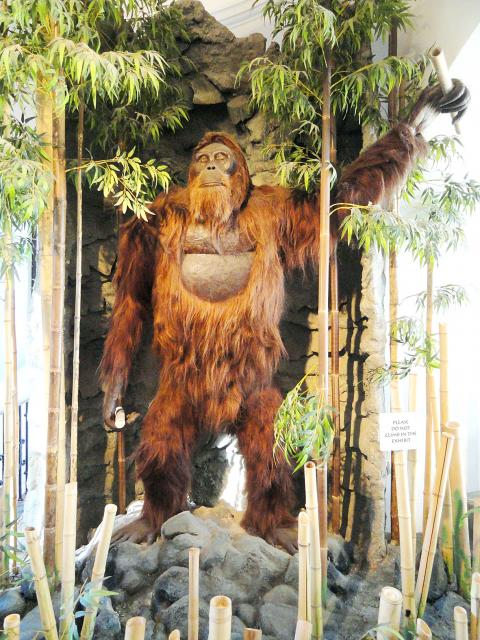The largest ape to roam Earth died out 100,000 years ago because it failed to tuck into savannah grass after climate change hit its preferred diet of forest fruit, scientists suggest.
Gigantopithecus — the closest Nature ever came to producing a real King Kong — weighed five times as much as an adult man and probably stood 3m tall, according to sketchy estimates.
In its heyday a million years ago, it inhabited semi-tropical forests in southern China and mainland Southeast Asia.

Photo courtesy of Wikimedia Commons
Until now, though, almost nothing was known about the giant’s anatomical shape or habits. The only fossil records are four partial lower jaws, and perhaps a thousand teeth — the first of which turned up in the 1930s in Hong Kong apothecaries where they were sold as “dragon’s teeth.”
These meagre remains “are clearly insufficient to say if the animal was bipedal or quadrupedal, and what would be its body proportions,” Herve Bocherens, a researcher at T|bingen University in Germany, says.
Its closest modern cousin is the orangutan, but whether Gigantopithecus had the same golden-red hue, or was black like a gorilla is unknown. Another mystery: its diet. Was it a meat-eater or a vegetarian? Did it share a taste for bamboo with its neighbour the prehistoric giant panda?

Photo courtesy of Wikimedia Commons
Answering this riddle might also tell us why a monster that surely had little to fear from other fauna went extinct.
ADAPT OR DIE
That’s where the teeth had a story to tell.
Examining slight variations in carbon isotopes found in tooth enamel, Bocherens and an international team of scientists showed that the primordial King Kong lived only in the forest, was a strict vegetarian, and probably wasn’t crazy about bamboo.
These narrow preferences did not pose a problem for Gigantopithecus until Earth was struck by a massive ice age during the Pleistocene Epoch, which stretched from about 2.6 million to 12,000 years ago.
That’s when nature, evolution — and perhaps a refusal to try new foods — conspired to doom the giant ape, Bocherens explained.
“Due to its size, Gigantopithecus presumably depended on a large amount of food,” he said.
“When during the Pleistocene, more and more forested area turned into savannah landscapes, there was simply an insufficient food supply.”
And yet, according to the study, other apes and early humans in Africa that had comparable dental gear were able to survive similar transitions by eating the leaves, grass and roots offered by their new environments. But for some reason, Asia’s giant ape — which was probably too heavy to climb trees, or swing in their branches — did not make the switch.
“Gigantopithecus probably did not have the same ecological flexibility and possibly lacked the physiological ability to resist stress and food shortage,” notes the study, which is to be published in a specialist journal, Quaternary International. Whether the mega-ape could have adapted to a changing world but didn’t, or whether it was doomed by climate and its genes, is probably one mystery that will never be solved. Climate change several hundred thousand years ago was also likely responsible for the disappearance of many other large animals from the Asian continent.

The Nuremberg trials have inspired filmmakers before, from Stanley Kramer’s 1961 drama to the 2000 television miniseries with Alec Baldwin and Brian Cox. But for the latest take, Nuremberg, writer-director James Vanderbilt focuses on a lesser-known figure: The US Army psychiatrist Douglas Kelley, who after the war was assigned to supervise and evaluate captured Nazi leaders to ensure they were fit for trial (and also keep them alive). But his is a name that had been largely forgotten: He wasn’t even a character in the miniseries. Kelley, portrayed in the film by Rami Malek, was an ambitious sort who saw in

Last week gave us the droll little comedy of People’s Republic of China’s (PRC) consul general in Osaka posting a threat on X in response to Japanese Prime Minister Sanae Takaichi saying to the Diet that a Chinese attack on Taiwan may be an “existential threat” to Japan. That would allow Japanese Self Defence Forces to respond militarily. The PRC representative then said that if a “filthy neck sticks itself in uninvited, we will cut it off without a moment’s hesitation. Are you prepared for that?” This was widely, and probably deliberately, construed as a threat to behead Takaichi, though it

Among the Nazis who were prosecuted during the Nuremberg trials in 1945 and 1946 was Hitler’s second-in-command, Hermann Goring. Less widely known, though, is the involvement of the US psychiatrist Douglas Kelley, who spent more than 80 hours interviewing and assessing Goring and 21 other Nazi officials prior to the trials. As described in Jack El-Hai’s 2013 book The Nazi and the Psychiatrist, Kelley was charmed by Goring but also haunted by his own conclusion that the Nazis’ atrocities were not specific to that time and place or to those people: they could in fact happen anywhere. He was ultimately

Nov. 17 to Nov. 23 When Kanori Ino surveyed Taipei’s Indigenous settlements in 1896, he found a culture that was fading. Although there was still a “clear line of distinction” between the Ketagalan people and the neighboring Han settlers that had been arriving over the previous 200 years, the former had largely adopted the customs and language of the latter. “Fortunately, some elders still remember their past customs and language. But if we do not hurry and record them now, future researchers will have nothing left but to weep amid the ruins of Indigenous settlements,” he wrote in the Journal of